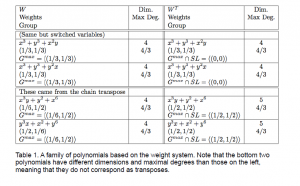Lisa Bendall, Dr. Tyler Jarvis, Math Department
Introduction.
Mirror symmetry is a phenomenon first observed in theoretical physics, which has garnered interest among mathematicians. The Landau-Ginzburg mirror symmetry conjecture proposes two algebraic structures which are isomorphic, or in some sense “mirror” each other. These structures are built from polynomials and corresponding symmetry groups.
Much research has already been done on the invertible class of polynomials. On the other hand, less is known about noninvertible polynomials. A key operation in building these algebraic structures is the “transpose” operation, which identifies a polynomial on one side of the mirror with its transpose polynomial on the other side, and similarly a symmetry group with its transpose group. For invertible polynomials, this operation is well-defined; however, for noninvertible polynomials, this operation is not defined. For my project, I explored how to define the transpose for any admissible polynomial, which includes both invertible and noninvertible polynomials.
Methodology.
A large number of noninvertible polynomials are related to invertible polynomials by having the same weights vector. On one side of the mirror, polynomials with the same weights create equivalent structures. In order to study a noninvertible polynomial, we studied the invertible representative to understand the structure. Because a noninvertible polynomial must have a noninvertible transpose, the transpose of the noninvertible polynomial may be related similarly to the transpose of the invertible representative. In addition, we made a couple assumptions based on known facts about transposing a noninvertible polynomial: 1. The transpose polynomial will have the same number of variables as the original polynomial. 2. The transpose of the maximal symmetry group will be the trivial group.
Results.
In some specific cases of polynomials, using a representative invertible polynomial yielded an obvious choice of the transpose of the noninvertible polynomial. However, this technique failed in other cases. In order for the two sides to be mirrors of each other, it is necessary (but not sufficient) for the dimension and maximal degrees to each be equal. Table 1 shows noninvertible polynomials on one side of the mirror on the right and possible transposes on the left. In this example, the polynomials do not have the same dimension or maximal degrees (columns 2 and 4), ruling out each other as candidates for the transpose polynomial.
Discussion.
Although we were unable to define the transpose operation for noninvertible polynomials, we were able to learn more about how it differs from the invertible case. First, the maximal symmetry group almost certainly will not correspond to the trivial group. Second, the transpose polynomial may have a different number of variables than the original polynomial, which is a much wider selection of candidates for the transpose of a polynomial. These results indicate that finding the transpose polynomial of a noninvertible polynomial is a much harder question than originally anticipated.
Conclusion.
While the original hypothesis was that the transpose of a non-invertible polynomial would be a simple extension of the invertible case, further investigation has revealed this is not the case. Through counter-examples, we have found that non-invertible polynomials do not follow the same rules which applied in the invertible case. If the transpose operation on a non-invertible polynomial is a valid operation, there is not an obvious way to find the corresponding polynomial or symmetry group. Further research can be done in the non-invertible case to examine whether the transpose operation is actually a well-defined operation.

